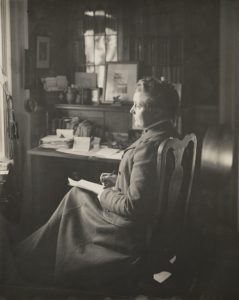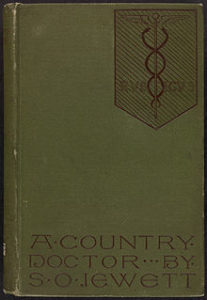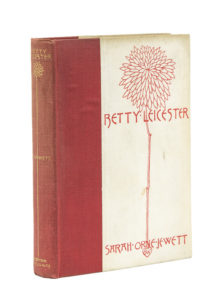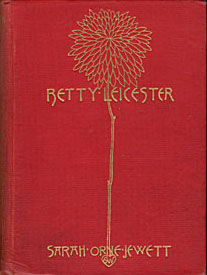Biography

SARAH ORNE JEWETT (1849-1909) set her books in the fictional towns of Deephaven and Dunnet Landing; Dunnet Landing is based clearly on South Berwick, Jewett’s birthplace. Critics have suggested that she wrote sequences of related short stories, vignettes stitched together tentatively as novels; they rely little on plotting and concentrate on a sense of place – the small seaports and inland terrain of the southern sea-coast of Maine. She wrote sympathetic portraits of life in her locality, its hardship and its isolation, certainly not sentimental. So much of her writing is autobiographical and incorporates her childhood experiences. Jewett would accompany her father, a local doctor, on his rounds when he visited the local fishermen and farmers, and she was made to recuperate from illness by walking long hours in her locality.
 Her first short story was published when she was 19; her first book, Deephaven, was published in 1877. From 1881 she lived mostly with the writer Annie Adams Fields after the death of Fields’ husband in what at the time was referred to as a ‘Boston Marriage’. From the late 1870s Jewett’s writing had been reviewed widely – favourably by Dean Howells, for instance, remarking that she possessed “an uncommon feeling for talk – I hear your people.” An early successful novel was A Country Doctor (1884); a volume of short stories, A White Heron, (1886) was well received. Some of her stories were translated by Thérèse Bentzon into French. Her writing career had gained some momentum when it was cut short suddenly in 1902: she sustained serious injury whilst travelling in a carriage.
Her first short story was published when she was 19; her first book, Deephaven, was published in 1877. From 1881 she lived mostly with the writer Annie Adams Fields after the death of Fields’ husband in what at the time was referred to as a ‘Boston Marriage’. From the late 1870s Jewett’s writing had been reviewed widely – favourably by Dean Howells, for instance, remarking that she possessed “an uncommon feeling for talk – I hear your people.” An early successful novel was A Country Doctor (1884); a volume of short stories, A White Heron, (1886) was well received. Some of her stories were translated by Thérèse Bentzon into French. Her writing career had gained some momentum when it was cut short suddenly in 1902: she sustained serious injury whilst travelling in a carriage.
She was to be a major influence on the writing of Willa Cather, who she met in 1908, and who was to edit Jewett’s work after her death.
 The Country of the Pointed Firs was published in November 1896, serialized first earlier in the year in The Atlantic Monthly, Jewett then expanded and revised for its book form, published by by Houghton, Mifflin and Company. It is considered to be Jewett’s finest book. Many describe it as a novella accompanied by short stories related in theme. Editions now tend to follow Willa Cather’s order of sequence used in the book’s 1923 edition. Cather thought it to be a masterpiece that would stand the test of time; Henry James thought it was a “beautiful little quantum of achievement.”
The Country of the Pointed Firs was published in November 1896, serialized first earlier in the year in The Atlantic Monthly, Jewett then expanded and revised for its book form, published by by Houghton, Mifflin and Company. It is considered to be Jewett’s finest book. Many describe it as a novella accompanied by short stories related in theme. Editions now tend to follow Willa Cather’s order of sequence used in the book’s 1923 edition. Cather thought it to be a masterpiece that would stand the test of time; Henry James thought it was a “beautiful little quantum of achievement.”
A young woman returns to Dunnet after an absence; she had made a brief visit to the town a few years previously. She is intent upon locking herself away to write her novel, and stays with Mrs Todd, a widow. Mrs Todd is the local apothecary and herbalist whose open, wise and kind-hearted ways position her as a nexus of the local community. The social to and fro frustrates the heroine, who rents a secluded school-room, although her company is sought still by members of the town. She becomes attached to each of her visitors and, against her will, becomes involved in the town’s idyllic community, where generations of families have forged strong, affectionate ties. Central to the lives of this neighbourhood of families is the sea coast and its wooded hinterland.
Jewett's book covers
SARAH W. WHITMAN (1842-1904), born in Massachusetts where she was socially well placed, married a wealthy wool merchant when 24. She started her artistic studies two years later in Boston. She travelled to Paris twice, the first time when aged 35 to study with Thomas Couture, who taught Manet and many other aspiring artists of the period; she visited Spain, Italy and England also for research. With no formal training or qualification, she had managed to establish herself as a prominent glass window designer – she set up her own studio, the Lily Glass Works, in Boston – and painter.
 She became also a designer of book covers, and from about 1884 until her death she designed over 220 books. She was a principal designer for Houghton Mifflin; Oliver Wendell Holmes and Celia Thaxter were, apart from Sarah One Jewett, perhaps the best known authors she designed for. She struck up a firm friendship with Sarah Orne Jewett that lasted until she died, and they corresponded tirelessly. Jewett welcomed Whitman’s critique and approval of her work. Jewett dedicated one volume of short stories, Strangers and Wayfarers (1890), to her. Fifteen of Jewett’s books have covers designed by Sarah Whitman.
She became also a designer of book covers, and from about 1884 until her death she designed over 220 books. She was a principal designer for Houghton Mifflin; Oliver Wendell Holmes and Celia Thaxter were, apart from Sarah One Jewett, perhaps the best known authors she designed for. She struck up a firm friendship with Sarah Orne Jewett that lasted until she died, and they corresponded tirelessly. Jewett welcomed Whitman’s critique and approval of her work. Jewett dedicated one volume of short stories, Strangers and Wayfarers (1890), to her. Fifteen of Jewett’s books have covers designed by Sarah Whitman.
Like Jewett, Whitman had, in many ways, a deep aesthetic sympathy for the romantic in real life. Both their artistic endeavours were informed by Emerson’s transcendentalism, a philosophy influenced by English Romanticism with an underlying belief that contact with nature and the natural world can only be spiritually restorative.
 Whitman’s book covers, influenced by the Arts and Crafts Movement and Art Nouveau, were essentially minimalist. She helped herald a more artistically self-conscious element of simplicity to book presentation in America. Her colour of choice for a binding was green, of all shades, and she used usually one other colour for the design, often a gold or deep red. She used linear drawing and silhouette to great effect, often asymmetrical; flower or plant emblems were employed frequently, including often her own ‘flaming heart’ motif.
Whitman’s book covers, influenced by the Arts and Crafts Movement and Art Nouveau, were essentially minimalist. She helped herald a more artistically self-conscious element of simplicity to book presentation in America. Her colour of choice for a binding was green, of all shades, and she used usually one other colour for the design, often a gold or deep red. She used linear drawing and silhouette to great effect, often asymmetrical; flower or plant emblems were employed frequently, including often her own ‘flaming heart’ motif.
With a background in stained glass design and manufacture, Whitman’s approach was unsurprisingly practical and utilitarian. She held that no compromise was necessary to attach her high artistic principles to the mass production of books; she saw no contradictions between her artistic purpose and financial constraint or an economy of scale. She addressed the Boston Arts Association:
“You have got to think how to apply elements of design to these cheaply sold books; to put the touch of art on this thing that is going to be produced at a level price, which allows for no handwork, the decoration to be cut with a die, the books to go out by the thousand and to be sold at a low price. . . What I feel is that under these conditions, the more necessary it is to design covers well because they are really like aesthetic tracts. They go everywhere.”
Jewett remained loyal to Whitman’s designs. In 1904,after Whitman’s death, in discussion with the publisher over a new printing of Betty Leicester, she wrote:
 “But will you please give directions at the Press that the old bindings should be restored to Betty Leicester? –the scarlet and white- for it is an ugly book at present; the die does not sit well sideways on the corner and this green and red cloth are very far from the beauty of Mrs. Whitman’s charming design.”
“But will you please give directions at the Press that the old bindings should be restored to Betty Leicester? –the scarlet and white- for it is an ugly book at present; the die does not sit well sideways on the corner and this green and red cloth are very far from the beauty of Mrs. Whitman’s charming design.”

More of Whitman’s book designs:
Bibliography
Sarah Orne Jewett’s Bibliography
1877: Deephaven
1878: Play Days
1879: Old Friends and New
1881: Country By-Ways
1884: The Mate of the Daylight, and Friends Ashore
1884: A Country Doctor
1885: A Marsh Island
1886: A White Heron and Other Stories
1887: The Story of the Norman
1888: The King of Folly Island and Other People
1890: Betty Leicester
1890: Tales of New England
1890: Strangers and Wayfarers
1893: A Native of Winby and Other Tales
1894: Betty Leicester’s English Christmas
1895: The Life of Nancy
1896: The Country of the Pointed Firs
1899: The Queens’ Twin and Other Stories
1901: The Tory Lover
1905: An Empty Purse
1911: Letters of Sarah Orne Jewett*
1916: Verses*
*posthumously published, edited by Annie Fields

 Her first short story was published when she was 19; her first book, Deephaven, was published in 1877. From 1881 she lived mostly with the writer Annie Adams Fields after the death of Fields’ husband in what at the time was referred to as a ‘Boston Marriage’. From the late 1870s Jewett’s writing had been reviewed widely – favourably by Dean Howells, for instance, remarking that she possessed “an uncommon feeling for talk – I hear your people.” An early successful novel was A Country Doctor (1884); a volume of short stories, A White Heron, (1886) was well received. Some of her stories were translated by Thérèse Bentzon into French. Her writing career had gained some momentum when it was cut short suddenly in 1902: she sustained serious injury whilst travelling in a carriage.
Her first short story was published when she was 19; her first book, Deephaven, was published in 1877. From 1881 she lived mostly with the writer Annie Adams Fields after the death of Fields’ husband in what at the time was referred to as a ‘Boston Marriage’. From the late 1870s Jewett’s writing had been reviewed widely – favourably by Dean Howells, for instance, remarking that she possessed “an uncommon feeling for talk – I hear your people.” An early successful novel was A Country Doctor (1884); a volume of short stories, A White Heron, (1886) was well received. Some of her stories were translated by Thérèse Bentzon into French. Her writing career had gained some momentum when it was cut short suddenly in 1902: she sustained serious injury whilst travelling in a carriage. The Country of the Pointed Firs was published in November 1896, serialized first earlier in the year in The Atlantic Monthly, Jewett then expanded and revised for its book form, published by by Houghton, Mifflin and Company. It is considered to be Jewett’s finest book. Many describe it as a novella accompanied by short stories related in theme. Editions now tend to follow Willa Cather’s order of sequence used in the book’s 1923 edition. Cather thought it to be a masterpiece that would stand the test of time; Henry James thought it was a “beautiful little quantum of achievement.”
The Country of the Pointed Firs was published in November 1896, serialized first earlier in the year in The Atlantic Monthly, Jewett then expanded and revised for its book form, published by by Houghton, Mifflin and Company. It is considered to be Jewett’s finest book. Many describe it as a novella accompanied by short stories related in theme. Editions now tend to follow Willa Cather’s order of sequence used in the book’s 1923 edition. Cather thought it to be a masterpiece that would stand the test of time; Henry James thought it was a “beautiful little quantum of achievement.”


 She became also a designer of book covers, and from about 1884 until her death she designed over 220 books. She was a principal designer for Houghton Mifflin; Oliver Wendell Holmes and Celia Thaxter were, apart from Sarah One Jewett, perhaps the best known authors she designed for. She struck up a firm friendship with Sarah Orne Jewett that lasted until she died, and they corresponded tirelessly. Jewett welcomed Whitman’s critique and approval of her work. Jewett dedicated one volume of short stories, Strangers and Wayfarers (1890), to her. Fifteen of Jewett’s books have covers designed by Sarah Whitman.
She became also a designer of book covers, and from about 1884 until her death she designed over 220 books. She was a principal designer for Houghton Mifflin; Oliver Wendell Holmes and Celia Thaxter were, apart from Sarah One Jewett, perhaps the best known authors she designed for. She struck up a firm friendship with Sarah Orne Jewett that lasted until she died, and they corresponded tirelessly. Jewett welcomed Whitman’s critique and approval of her work. Jewett dedicated one volume of short stories, Strangers and Wayfarers (1890), to her. Fifteen of Jewett’s books have covers designed by Sarah Whitman. Whitman’s book covers, influenced by the Arts and Crafts Movement and Art Nouveau, were essentially minimalist. She helped herald a more artistically self-conscious element of simplicity to book presentation in America. Her colour of choice for a binding was green, of all shades, and she used usually one other colour for the design, often a gold or deep red. She used linear drawing and silhouette to great effect, often asymmetrical; flower or plant emblems were employed frequently, including often her own ‘flaming heart’ motif.
Whitman’s book covers, influenced by the Arts and Crafts Movement and Art Nouveau, were essentially minimalist. She helped herald a more artistically self-conscious element of simplicity to book presentation in America. Her colour of choice for a binding was green, of all shades, and she used usually one other colour for the design, often a gold or deep red. She used linear drawing and silhouette to great effect, often asymmetrical; flower or plant emblems were employed frequently, including often her own ‘flaming heart’ motif. “But will you please give directions at the Press that the old bindings should be restored to Betty Leicester? –the scarlet and white- for it is an ugly book at present; the die does not sit well sideways on the corner and this green and red cloth are very far from the beauty of Mrs. Whitman’s charming design.”
“But will you please give directions at the Press that the old bindings should be restored to Betty Leicester? –the scarlet and white- for it is an ugly book at present; the die does not sit well sideways on the corner and this green and red cloth are very far from the beauty of Mrs. Whitman’s charming design.”


 Allen Lane, the founder of Penguin books, was a man who liked to be seen riding a virtuous horse though his spurs were as sharp as an abacus: money was his game and he chanced to sell his new Penguin range through his Penguincubator in 1937, in tobacconists alongside newspapers and boiled sweets, also a few placed as concessions in branches of F. W. Woolworth’s. One Penguincubator was commissioned at Charing Cross Station, placed next to a machine vending cigarettes. (6d the price of a packet of fags, 6d the price of the first Penguins, though am not sure if Lane had thought through how you were supposed to keep the books alight without a filter.) Booksellers in the Charing Cross locality objected to the Penguincubator and it was removed. It would seem that they were never successful in any case.
Allen Lane, the founder of Penguin books, was a man who liked to be seen riding a virtuous horse though his spurs were as sharp as an abacus: money was his game and he chanced to sell his new Penguin range through his Penguincubator in 1937, in tobacconists alongside newspapers and boiled sweets, also a few placed as concessions in branches of F. W. Woolworth’s. One Penguincubator was commissioned at Charing Cross Station, placed next to a machine vending cigarettes. (6d the price of a packet of fags, 6d the price of the first Penguins, though am not sure if Lane had thought through how you were supposed to keep the books alight without a filter.) Booksellers in the Charing Cross locality objected to the Penguincubator and it was removed. It would seem that they were never successful in any case.